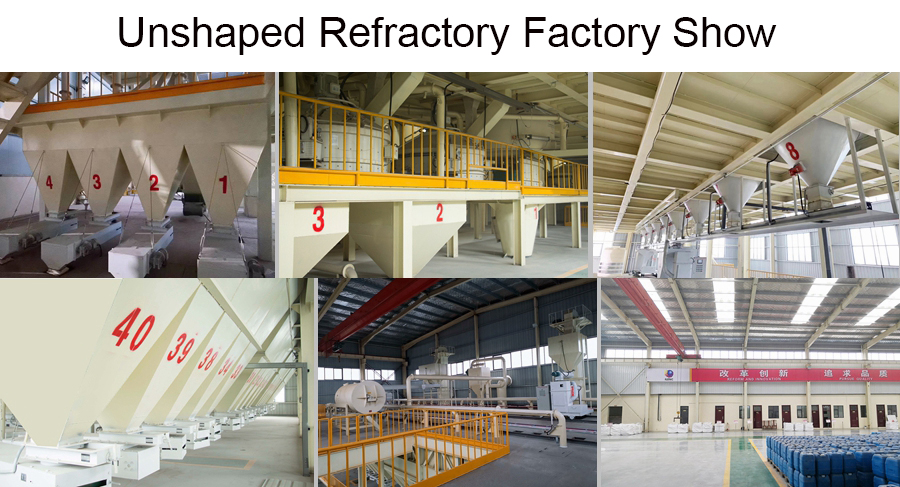1. According to the apparent porosity, it can be divided into two categories: dense materials and thermal insulation materials. The true porosity of thermal insulation materials is not less than 45%.
2. According to the bonding form, it can be divided into: ceramic bonding (T), hydraulic bonding (S), chemical bonding (H), and organic bonding (Y).
3. Classification based on the main chemical composition (mineral composition) of the entire mixture and/or the properties of the aggregates that determine the characteristics of the mixture. There are siliceous refractory materials, clay refractory materials, magnesia refractory materials, dolomite refractory materials and so on.
4. According to the construction method, it can be divided into: refractory castables, refractory ramming materials, refractory plastics, refractory pressed materials, refractory spray coatings, refractory mud, refractory coating materials, etc.
The editor below will briefly introduce several amorphous refractory materials to you.
(1) Silicon refractory materials
Silica refractory materials are refractory materials with silica as the main component. Usually the silica content is not less than 93%. The main variety is silica bricks. Using silica as raw material and calcined at 1350~1430℃, the true density must be in the range of 2.31~2.42 grams per cubic centimeter. It has the advantages of high thermal conductivity and load softening point, and strong resistance to acidic slag erosion.
(2) Dolomite refractory materials
It is an alkaline refractory material with dolomite as the main raw material and calcium oxide and magnesium oxide as the main components. The calcium oxide content is 40% to 60%, and the magnesium oxide content is 30% to 40%. According to the chemical mineral composition, it is divided into two categories: dolomite refractory materials containing free lime and dolomite refractory materials without free lime.
3) Pouring material
Pouring material is a material that has good fluidity after being mixed with water. After forming, it needs to be properly cured to condense and harden, and then it can be used after being baked according to a certain system. The grouting material uses aluminum silicate clinker, corundum material or alkaline refractory clinker as aggregate; the lightweight grouting material uses expanded perlite, vermiculite, ceramsite, and alumina hollow balls as aggregate. Calcium aluminate cement, water glass, ethyl silicate, polyaluminum chloride, clay or phosphate are used as binding agents. Admixtures depend on usage conditions, and their role is to improve construction performance and improve physical and chemical properties.
(4) Plastic refractory
Plastic mud or clay. When appropriate external force is applied, it is easy to deform without cracking; after the stress is eliminated, it will no longer deform. Plastic materials include semi-silica, clay, high alumina, zircon, carbon, etc., and there are also lightweight plastics. Plastics must add plasticizing materials, which are mostly highly plastic clays. Plasticizers can also be used to improve the plasticity of this clay. The binding agents used in plastics include plastic clay, phosphoric acid, aluminum dihydrogen phosphate, aluminum sulfate, etc. Aluminum oxide added with phosphoric acid or phosphate binder can be plasticized. During the storage process, it will chemically react with alumina to form insoluble aluminum orthophosphate and harden the mud. Therefore, preservatives such as oxalic acid, citric acid, and acetyl must be added. Acetone etc.
What are the characteristics of unshaped refractory materials?
1. The preparation process is simple, the production cycle is short, and the productivity is high;
2. Strong adaptability, it is not limited by the structural shape of industrial kilns when used, and can be made into any shape;
3. Good integrity, good air tightness and large thermal resistance, which can reduce the heat loss of industrial furnaces and save energy;
4. Convenient for mechanized construction, saving labor and time;
5. The damaged industrial furnace lining can be easily repaired with amorphous refractory materials, which can extend the service life of the lining and reduce the consumption of refractory materials.
What are the precautions for unshaped refractory materials?
1. Select appropriate unshaped refractory materials according to different furnaces and different parts.
2. Strictly follow the construction requirements to achieve uniform vibration and leave expansion joints.
3. Respect science, bake the oven strictly according to the curve, and remember to shorten the oven time in order to meet the production volume.
4. Store in a cool, ventilated warehouse. The humidity in the warehouse should not be greater than 85%. The packaging must be completely sealed to prevent moisture absorption.
5. They should be stored separately from flammable (combustible) substances, acids, etc., and avoid mixed storage. Suitable materials should be available in the storage area to contain spills.



